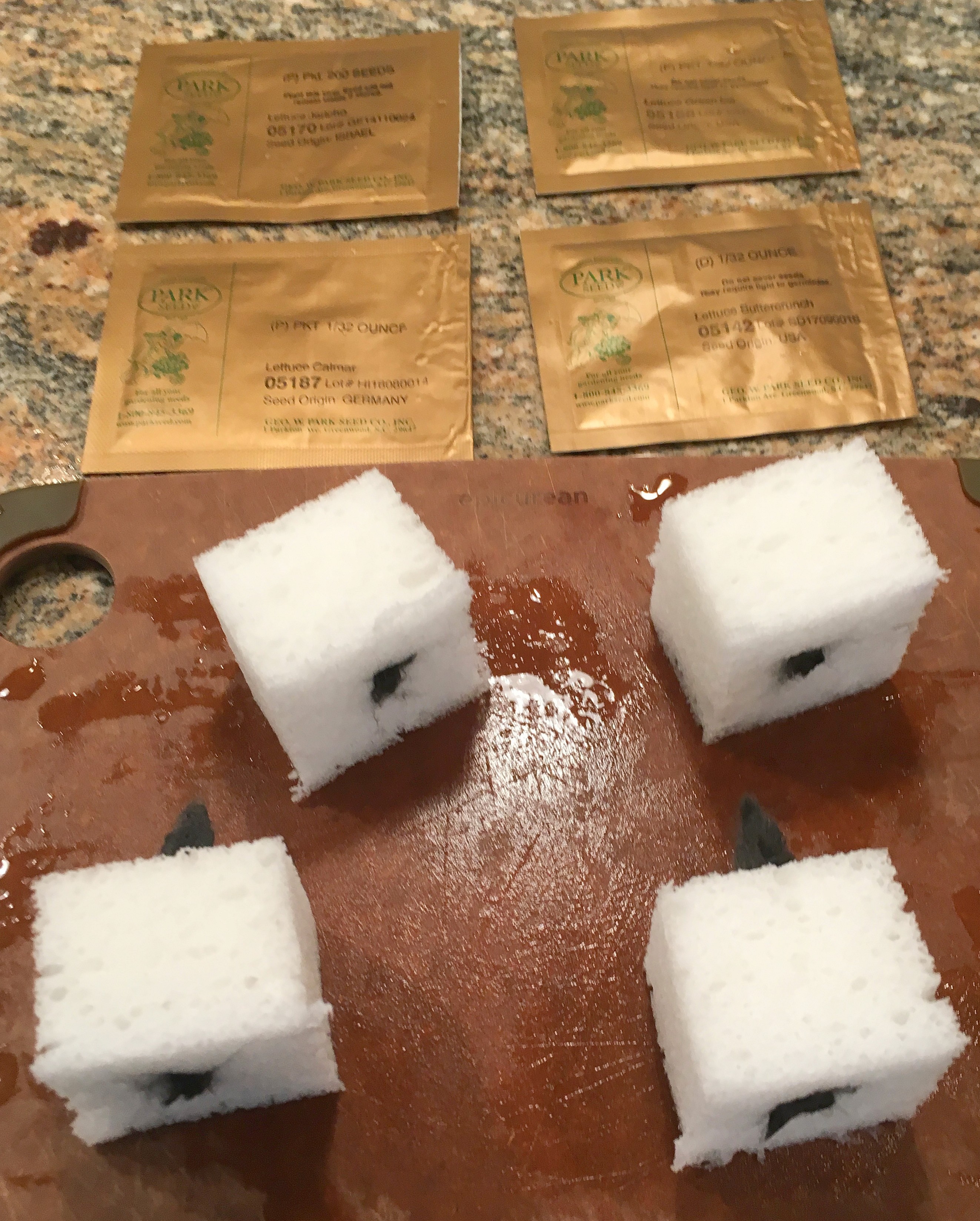I'm testing 4 different kinds of lettuce, Buttercrunch, Green Ice, Jericho Hybrid, and Calmar.

Lettuce seeds are very small, so tweezers are required for planting. Note that with my middle-age eyes, I need to use a magnifying visor to see the seeds well enough to grab them. The seeds are initially soaked in a shallow bowl to moisten them and increase the chance of germination. You have to actively sink the seeds, since they will float on top due to surface tension. Only seeds that sink the the bottom are used. If they won't sink, then they probably won't germinate.
After dampening the sponge blocks in water, use the tweezers to pull the seeds from the bottom of the bowl and plant them slightly apart in the fiber portion of the block. One end of the seed is very pointy and the other end is slightly rounded. The pointy end goes down. If you plant them pointy side up, the seeds may still still sprout, but the root may dry out and die before it can grow back into the fiber wick.
I'll post an update at the end the week with any progress. Note that this is the first time that I am testing the cellulose sponge blocks instead of the reticulated foam blocks, so the planting experiment could fail.

 Chris Johnson
Chris Johnson
Discussions
Become a Hackaday.io Member
Create an account to leave a comment. Already have an account? Log In.
After running for the system several hours, the Delrin threaded rod started to have the same friction problems as the Nylon rod. I guessed that this might be due to water splashes drying on the threaded rod after it has been running for a while, leaving behind a dried fertilizer residue. The vertical drain tube had been modified to direct the vertical water stream away from the central Tee in the pipe base in order to avoid dripping where the Tee passes through the pipe base wall. It turns out that the threaded rod works much better when it's wet. After changing the drain tube back so that the threaded rod is in the vertical water stream, the torque required to close the value is much lower and it consistently holds 45 to 50 PSI. Wet Delrin seems to be much more slippery than dry/crusty Delrin.
Now that the valve seems to be working reliably, I have started some more seedlings and will report back with more info when they have sprouted.
Are you sure? yes | no
I changed to the 10-32 Delrin (acetal) threaded rod and now get higher PSI when closing the valve. I ran it in 1 minute cycles for about 6 hours with no issues. I will be starting another batch of seedlings tomorrow using two reticulated foam blocks and two cellulose foam blocks to see if there is a difference now that the spray pressure is higher. I also have some FDA food grade lubricant that should arrive later in the week. Using it on the threaded rod should allow for more consistent valve operation.
Are you sure? yes | no
It seems that the cellulose sponges may not work as well as the reticulated foam. They do not appear to keep the seeds as well hydrated. However, reduced moisture could also be due to an issue with the valve pressure. I will be changing the threaded rod that runs the valve from Nylon to Delrin. That will hopefully reduce the friction and increase the spray pressure. The parts should arrive tomorrow. I'll have to restart the test, since while all the seeds sprouted, they stopped growing after a couple of days.
Are you sure? yes | no
I connected up a webcam to the RPi and have it viewing the top of the tower. The software takes a picture every other 5 minute spray cycle, which is one frame every 10 minutes. Once enough frames a available, they can be combined into a time lapse movie. At 30 frames/second, the video shows five hours of growing time per second of video time. This is about 5 seconds of video per day of growth. When you see it in time lapse, it's actually pretty amazing how much things grown in a day.
Are you sure? yes | no
After only 24 hours, two of the Buttercrunch seeds are visibly sprouting!!
Are you sure? yes | no